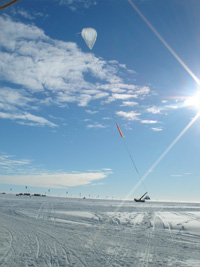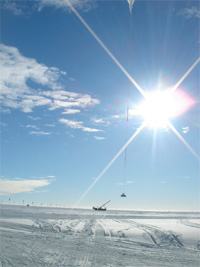On December 23, the BESS-Polar experiment team launched a superconducting spectrometer with a large balloon from Williams Field near McMurdo Station, Antarctica. The team seeks to observe the flux of cosmic antiprotons and to search for possible, exotic primary sources of antiprotons, comparing with the result from the flight in 2004 and from previous BESS flights .
The baloon-borne instrument is now circling around the south pole at the floating altitude of 110 - 120KFt (35 ~ 37km), and the balloon-borne spectrometer has started scientific observation, which is continued during the flight over antarctica for 20 days.
The BESS experiment is carried out as an international cooperation among KEK, University of Tokyo, Kobe University, ISAS/JAXA (Japan), NASA-GSFC, University of Maryland, and University of Denver, based on the cooperative program in Space Science agreed by NASA and ISAS/JAXA. The balloon flight operation is carried out by the NASA Columbia Scientific Balloon Facility. The facility support is provided by the NSF United States Antarctic Program.
This experiment is supported by Kakenhi/Grant-in-Aid for Scientific Reseach S and RESCEU (the Univ. of Tokyo) in Japan, and by NASA in the USA.
|

 |



